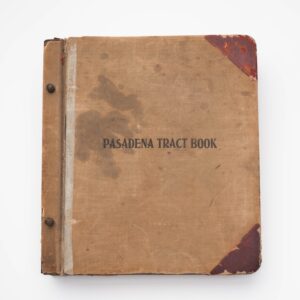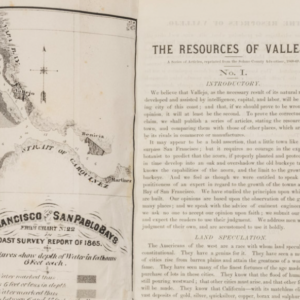Marvelous 1872 geological treatise with color diagrams of the Earth’s stratigraphy.
Geologische Wandtafeln für den Anschauungs-Unterricht.
Out of stock
Description
This is an attractive and interesting presentation of contemporary geological theory, published in 1872 by an eminent German geologist. The 19th century saw great advances in the field of geology, both in methodology and in our understanding of the geologic history of the Earth. Especially important was the concept of stratigraphy — that different strata could be identified by rock and fossil contents and thus each stratum could be assigned to a unique position in a sequence. Fossils and rocks could in this way be assigned relative ages, allowing for a more universal, scientific approach to dating and analysis.
The present work consists of four diagrams, each depicting the geological strata of the Earth as defined at the time. The angles of the rock layers and their relationships is representative of the faulting that would have caused them to break and tilt and move relative to each other.
We discuss each plate in turn, with labels translating the German:
DIAGRAM 1: Silurian to Permian
Silurian (443.8 — 419.2 million years ago)
A significant evolutionary milestone during the Silurian was the diversification of jawed fish and bony fish. Multi-cellular life also began to appear on land in the form of small, bryophyte-like and vascular plants that grew beside lakes, streams, and coastlines, and terrestrial arthropods are also first found on land during the Silurian.
Devonian (419.2 — 358.9 mya)
Named after Devon, England, where rocks from this period were first studied.
The first significant adaptive radiation of life on dry land occurred during the Devonian. Free-sporing vascular plants began to spread across dry land, forming extensive forests which covered the continents.
Fish reached substantial diversity during this time, and the Devonian is often called the “Age of Fish.” The ancestors of all four-limbed vertebrates (tetrapods) began adapting to walking on land, as their strong pectoral and pelvic fins gradually evolved into legs.
Carboniferous (358.9 — 298.9 mya)
The name Carboniferous means “coal-bearing.” Based on a study of the British rock succession, it was the first of the modern ‘system’ names to be employed, and reflects the fact that many coal beds were formed globally during that time.
Amphibians were the dominant land vertebrates, of which one branch would eventually evolve into amniotes, the first solely terrestrial vertebrates.
Permian (298.9 — 251.9 mya)
The last period of the Paleozoic era; the following Triassic period belongs to the Mesozoic era.
The concept of the Permian was introduced in 1841 by geologist Sir Roderick Murchison, who named it after the city of Perm in Russia.
The world at the time was dominated by two continents known as Pangaea and Siberia, surrounded by a global ocean called Panthalassa.
The Permian (along with the Paleozoic) ended with the Permian–Triassic extinction event, also known as the Great Dying, the largest mass extinction in Earth’s history, in which nearly 96% of marine species and 70% of terrestrial species died out. It would take well into the Triassic for life to recover from this catastrophe. Suggested mechanisms for the latter include one or more large meteor impact events, massive volcanism such as that of the Siberian Traps, and the ensuing coal or gas fires and explosions, and a runaway greenhouse effect triggered by sudden release of methane from the sea floor due to methane clathrate dissociation according to the clathrate gun hypothesis or methane-producing microbes known as methanogens. Possible contributing gradual changes include sea-level change, increasing anoxia, increasing aridity, and a shift in ocean circulation driven by climate change.
DIAGRAM 2: Triassic, Jurassic, Cretaceous (Dinosaurs!)
Triassic (251.9 — 201.3 mya)
The Triassic is the first period of the Mesozoic Era. Both the start and end of the period are marked by major extinction events.
Therapsids and archosaurs were the chief terrestrial vertebrates during this time. A specialized subgroup of archosaurs, called dinosaurs, first appeared in the Late Triassic but did not become dominant until the succeeding Jurassic Period.
The first true mammals, themselves a specialized subgroup of therapsids, also evolved during this period, as well as the first flying vertebrates, the pterosaurs, who, like the dinosaurs, were a specialized subgroup of archosaurs. The vast supercontinent of Pangaea existed until the mid-Triassic, after which it began to gradually rift into two separate landmasses, Laurasia to the north and Gondwana to the south.
The global climate during the Triassic was mostly hot and dry, with deserts spanning much of Pangaea’s interior.
Jurassic (201.3 — 145 mya)
The Jurassic constitutes the middle period of the Mesozoic Era, also known as the Age of Reptiles. The Jurassic is named after the Jura Mountains within the European Alps, where limestone strata from the period were first identified.
On land, there was a transition from Triassic fauna, dominated by both dinosauromorph and crocodylomorph archosaurs, to one dominated by dinosaurs alone. The first birds also appeared during the Jurassic, having evolved from a branch of theropod dinosaurs.
Other major events include the appearance of the earliest lizards, and the evolution of therian mammals, including primitive placentals. Crocodilians made the transition from a terrestrial to an aquatic mode of life. The oceans were inhabited by marine reptiles such as ichthyosaurs and plesiosaurs, while pterosaurs were the dominant flying vertebrates.
Cretaceous (145 — 66 mya)
The Cretaceous Period is usually abbreviated K, for its German translation Kreide (chalk in Latin). It is the last period of the Mesozoic Era.
During this time, new groups of mammals and birds, as well as flowering plants, appeared. The Cretaceous (along with the Mesozoic) ended with the Cretaceous–Paleogene extinction event, a large mass extinction in which many groups, including non-avian dinosaurs, pterosaurs and large marine reptiles died out. The end of the Cretaceous is defined by the abrupt Cretaceous–Paleogene boundary (K–Pg boundary), a geologic signature associated with the mass extinction which lies between the Mesozoic and Cenozoic eras.
As originally proposed in 1980 by a team of scientists led by Luis Alvarez and his son Walter Alvarez, it is now generally thought that the K–Pg extinction was caused by the impact of a massive comet or asteroid 10 to 15 km (6 to 9 mi) wide, 66 million years ago, which devastated the global environment, mainly through a lingering impact winter which halted photosynthesis in plants and plankton.
DIAGRAM 3: Eocene, Miocene, Pliocene
Paleogene (66 — 23.03 mya)
The Paleogene is most notable for being the time during which mammals diversified from relatively small, simple forms into a large group of diverse animals in the wake of the Cretaceous–Paleogene extinction event that ended the preceding Cretaceous Period.
This period consists of the Paleocene, Eocene, and Oligocene epochs.
Eocene: The name Eocene comes refers to the “dawn” of modern fauna that appeared during the epoch.
Miocene (23.03 —5.33 mya)
The Miocene was named by Charles Lyell. As the earth went from the Oligocene through the Miocene and into the Pliocene, the climate slowly cooled towards a series of ice ages.
Apes arose and diversified during the Miocene, becoming widespread in the Old World. By the end of this epoch and the start of the following one, the ancestors of humans had split away from the ancestors of the chimpanzees to follow their own evolutionary path during the final Messinian stage (7.2 – 5.3 mya) of the Miocene.
Pliocene (5.33 — 2.58 mya)
South America became linked to North America through the Isthmus of Panama during the Pliocene, making possible the Great American Interchangeand bringing a nearly complete end to South America’s distinctive large marsupial predator and native ungulate faunas. The formation of the Isthmus had major consequences on global temperatures, since warm equatorial ocean currents were cut off and an Atlantic cooling cycle began, with cold Arctic and Antarctic waters dropping temperatures in the now-isolated Atlantic Ocean.
Africa’s collision with Europe formed the Mediterranean Sea, cutting off the remnants of the Tethys Ocean.
DIAGRAM 4: Pleistocene
Pleistocene (2.58 mya — 11,700 years ago)
Aka the Ice Age. The end of the Pleistocene corresponds with the end of the last glacial period and also with the end of the Paleolithic age used in archaeology.
Charles Lyell introduced the term “pleistocene” in 1839 to describe strata in Sicily that had at least 70% of their molluscan fauna still living today. This distinguished it from the older Pliocene epoch, which Lyell had originally thought to be the youngest fossil rock layer.
The modern continents were essentially at their present positions during the Pleistocene, the plates upon which they sit probably having moved no more than 100 km relative to each other since the beginning of the period.
Both marine and continental faunas were essentially modern but with many more large land mammals such as mammoths and mastodons. Isolated places such as Australia, Madagascar, New Zealand and islands in the Pacific saw the evolution of large birds and even reptiles.
A major extinction event of large mammals (megafauna) began late in the Pleistocene and continued into the Holocene. Neanderthals also became extinct during this period.
The evolution of anatomically modern humans took place during the Pleistocene. In the beginning of the Pleistocene, Paranthropus species are still present, as well as early human ancestors, but during the lower Palaeolithic they disappeared, and the only hominin species found in fossilic records is Homo erectus for much of the Pleistocene.
An interesting aspect of diagram 4 is the depiction of tilted layers of Silurian and Devonian rock which have been reverse faulted and pushed up over the younger layers at the edge of the ocean.
Cartographer(s):
Dr. Oscar Friedrich von Fraas (1824—1897) was a German clergyman, paleontologist, and geologist. In 1854 he was named curator of the department of mineralogy and paleontology at the Royal Württemberg museum of natural history in Stuttgart.
Condition Description
Covers moderately worn, diagrams all in very good condition. Diagram 4 has some foxing, visible on the verso.
References




















